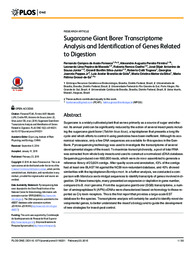Sugarcane giant borer transcriptome analysis and identification of genes related to digestion.
Sugarcane giant borer transcriptome analysis and identification of genes related to digestion.
Autoria: FONSECA, F. C. de A.; FIRMINO, A. A. P.; MACEDO. L. L. P. de; COELHO, R. R.; SOUSA JÚNIOR, J. D. A. de; SILVA JUNIOR, O. B.; TOGAWA, R. C.; PAPPAS JUNIOR, G. J.; GÓIS, L. A. B. de; SILVA, M. C. M. da; SA, M. F. G. de
Resumo: Sugarcane is a widely cultivated plant that serves primarily as a source of sugar and ethanol. Its annual yield can be significantly reduced by the action of several insect pests including the sugarcane giant borer (Telchin licus licus), a lepidopteran that presents a long life cycle and which efforts to control it using pesticides have been inefficient. Although its economical relevance, only a few DNA sequences are available for this species in the Gen-Bank. Pyrosequencing technology was used to investigate the transcriptome of several developmental stages of the insect. To maximize transcript diversity, a pool of total RNA was extracted from whole body insects and used to construct a normalized cDNA database. Sequencing produced over 650,000 reads, which were de novo assembled to generate a reference library of 23,824 contigs. After quality score and annotation, 43% of the contigs had at least one BLAST hit against the NCBI non-redundant database, and 40% showed similarities with the lepidopteran Bombyx mori. In a further analysis, we conducted a comparison with Manduca sexta midgut sequences to identify transcripts of genes involved in digestion. Of these transcripts, many presented an expansion or depletion in gene number, compared to B. mori genome. From the sugarcane giant borer (SGB) transcriptome, a of aminopeptidase N (APN) cDNAs were characterized based on homology to those reported as Cry toxin receptors. This is the first report that provides a large-scale EST database for the species. Transcriptome analysis will certainly be useful to identify novel developmental genes, to better understand the insect?s biology and to guide the development of new strategies for insect-pest control.
Ano de publicação: 2015
Tipo de publicação: Artigo de periódico
Palavras-chave: Broca Gigante, Controle Biológico, Praga
Observações
1 - Por padrão são exibidas publicações dos últimos 20 anos. Para encontrar publicações mais antigas, configure o filtro ano de publicação, colocando o ano a partir do qual você deseja encontrar publicações. O filtro está na coluna da esquerda na busca acima.
2 - Para ler algumas publicações da Embrapa (apenas as que estão em formato ePub), é necessário ter, no celular ou computador, um desses softwares gratuitos. Sistemas Android: Google Play Livros; IOS: iBooks; Windows e Linux: software Calibre.
Acesse outras publicações
Acesse a Base de Dados da Pesquisa Agropecuária (BDPA) para consultar o acervo completo das bibliotecas da Embrapa.

